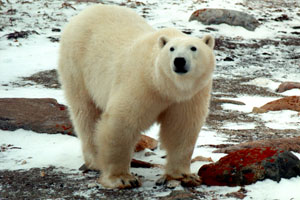The Polar Bear

The polar bear (Ursus maritimus) is the largest land-based carnivore in the world today. A live bear is an awe-inspiring sight, with the largest males weighing up to 800 kilograms, and measuring 2-3 metres in length. Females are slightly smaller than males. In comparison with other bears, the polar bear has a long neck and legs. The head and body are streamlined, reflecting its adaptation to swimming. In fact, the Latin name of the polar bear, Ursus maritimus, means "bear of the sea." Its front legs and paws are used for paddling and the hind legs serve as a rudder. The polar bear is also adapted for extreme cold. Its thick, cream-coloured fur insulates both in and out of the water. In addition, the bear's small ears minimize heat loss, and a thick layer of fat under its black skin stores energy. In summer, polar bears prevent themselves from getting overheated by panting, and losing heat through their tongue, lips, ears, foot pads and snout.